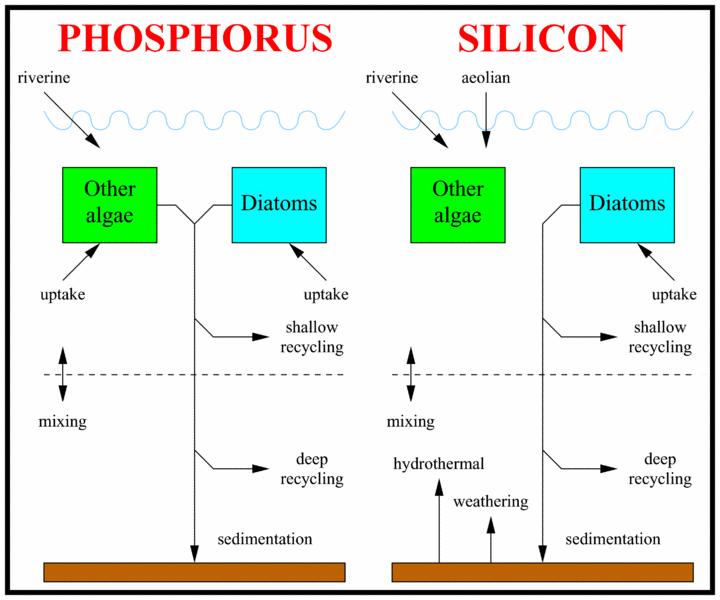
As with any model, simplification has both advantages and disadvantages. This article describes some of the silicon-phosphorus model cons.
Types of Models
In computer modelling there is a continuum between two caricature classes of models:
conceptual-type models that aim to simplify a system down to include only its most important elements, in particular those that govern its behaviour
simulation-type models that are highly detailed and try whenever possible to avoid making assumptions about what is important; instead they try to include as much detail as possible in the expectation that nothing important will be omitted
By simplifying to only the most important fluxes and state variables, this model is very much a conceptual-type model.
Disadvantages
Potential weaknesses of a conceptual approach include the likelihood of omitting something important. Every assumption runs the risk of being incorrect in an important way and thereby divorcing the model results from reality. It only takes one unreasonable assumption or omission, if it relates to a key part of the system, to invalidate the model's results.
Some of the major simplifications made in the silicon-phosphorus model are as follows:
1. The representation of biology is extremely simplified. Limitation of growth rate due to light, temperature and other nutrients (for instance, nitrate and iron) are not included at all in the model. The omission of iron, in particular, is a potentially critical deficiency of the model, because observational evidence suggests that diatoms have anomalously high Si:P ratios in iron-deplete regions such as the Southern Ocean.
2. There is no day-night cycle and no seasonal cycle in the model.
3. Horizontal variations are completely ignored. The model is unable to simulate differences between different ocean basins, between high and low latitudes, or between deep and shallow water environments. The model is therefore suitable only for calculating average global responses.
4. Vertical variations can only be captured in an approximate way due to only two boxes in the vertical.
5. Only the major fluxes are included. Fluxes deemed to be of lesser importance, such as the delivery of phosphorus to the surface ocean within dust, are not included.
6. Only two different types of phytoplankton are simulated in the model.
7. Only inorganic phosphate is modelled. Dissolved organic phosphate (DOP) is not modelled.
8. When under silicon stress in the real world, diatoms can decrease their silicon requirement to below the ideal Si:P ratio. In the model, nutrient stress can only increase this ratio (under conditions where phosphate is more limiting than silicic acid).
The motivation for all of these omissions is the expectation that their addition would not fundamentally change the behaviour of the model. It is predicted that adding these features would not greatly alter the model's general response to, for instance, changes in the amount of phosphorus in the ocean, or changes in the input rate of phosphate down rivers.
For many of the cases above sensitivity analyses have been performed to test these assumptions. The large majority found that the main results were obtained regardless of whether or not we made the assumptions listed above. More information on these, and other, sensitivity analyses can be found in Yool & Tyrrell (2003).
Other related pages
Silicon-phosphorus model overview
Silicon-phosphorus model details
Silicon-phosphorus model pros
Silica burp hypothesis
Silicon-phosphorus model worksheet
Refrences
Yool, A. & Tyrrell, T. (2003). Role of diatoms in regulating the ocean's silicon cycle. Global Biogeochemical Cycles 17, 1103, doi:10.1029/2002GB002018.t
External links
Description of the chemical element silicon
Diagram of the silicon cycle
Description of the chemical element phosphorus
Description of the phosphorus cycle